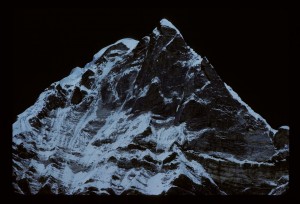 Every pianist grows up with a sixth sense, an inculcated suspicion that various keys might be guilty of certain crimes, certain assumed identities, masks hand-tooled by composers who have already decided on the disguises for their own pieces in those keys, but disguises which are possibly intrinsic to the keys themselves. Whether a composition determines the nature of the key, or the key of the composition, the result seems to be the same, that most pieces in the same key share an uncanny number of facial resemblances and family memories.
Every pianist grows up with a sixth sense, an inculcated suspicion that various keys might be guilty of certain crimes, certain assumed identities, masks hand-tooled by composers who have already decided on the disguises for their own pieces in those keys, but disguises which are possibly intrinsic to the keys themselves. Whether a composition determines the nature of the key, or the key of the composition, the result seems to be the same, that most pieces in the same key share an uncanny number of facial resemblances and family memories.
The instinct that made Chopin write a cradle song in D flat is the same premonition which makes a pianist know intuitively that D flat is a somnolent lullaby of a key, partly because he is aware of that Berceuse and other similar pieces in D flat, but mainly because D flat would lend itself to such harmonies of the evening even without Liszt’s Harmonies du Soir to argue its stained-glass case.
D FLAT
Having colored hearing, or synesthesia, both Nabokov and his wife Véra experienced tastes and colors at the sounds of letters (“steely x, thundercloud z, and huckleberry k . . . , creamy d, bright-golden y, . . . the drab shoelace of h . . .”). Nabokov was as sensitive to spaces as to colors, note “the green drawing room (where an odor of fir, hot wax and tangerines would linger long after Christmas had gone).”
Such syntheses color the musician’s mind. Each piece you play takes on the scents and sights of its rustling audience, rusting salon, roasting dusk, the dripping post-rain trees and rumbling summer evening creeping in around the notes through the valanced mahogany muntins, every hasty trill, balanced leap, and improvised sforzando immortalized in its own amber light, to be brought up precisely before the note in question is repeated again, limber enough to be resurrected thirty years later from the throng of similar aspirants waiting in the plush lounge of hindsight to be called in at will, not by premeditation, but out of whimsy, instinct, folly.
As well as the lighting, many musicians have productive associations with various keys, from the overeager, juvenile, bushy-tailed C to the voluptuous velour seraglio of G flat. C sharp is almost dedicated to Rachmaninoff and Scriabin in its fury and aggression. D flat involves exactly the same notes on the keyboard as C sharp, but the tones are produced by the calming flat, not the hair-raising sharp, creating a drowsy lushness, an overgrown ravine hidden in the rolling countryside, enveloped by glades and bosks, by Constable and Corot, the fallen apple midsummer before a warm caramel storm. A smug sunset leads to the Jane Austen inevitability of dinner and love on the moors.
 I’ve chosen these pieces because to me they cling to that nocturnal trellis that lives only in the world of D flat. The dreams they provoke are not accidental. The moods they inspire must be similar to the same moods that brought them into the world. That is, they re-create themselves easily, assuming the pianist doesn’t trip over them, but has the foresight instead to slip into the hedges and wait for thunder.
I’ve chosen these pieces because to me they cling to that nocturnal trellis that lives only in the world of D flat. The dreams they provoke are not accidental. The moods they inspire must be similar to the same moods that brought them into the world. That is, they re-create themselves easily, assuming the pianist doesn’t trip over them, but has the foresight instead to slip into the hedges and wait for thunder.
C MAJOR
Each key has its calling card. The key of C is a plain Jane planet, bland and juvenile, lending itself to the things of childhood, such as Mozart’s Sonata, his Rondo, Debussy’s Dr. Gradus Ad Parnassum, and Prokofiev’s gleeful kindergarten romp of a concerto. Why such simplicity? C major, being the easiest key, because it has none of those fingertripping, eye-stopping sharps or flats, is the first any pianist or composer learns, and thus identifies with the naive memories of first love, those awkward arpeggios, banal beauties, and comforting chords we learn with the light slanting depressingly through our grandparents’ Victorian blinds, every detail of those rooms as branded on our lives as those deficient compositions themselves, certain scales recalling for no reason the fuzz on the grim rug, the grime on the ivories, every nonmusical event memorized, along with its equally dubious musical themes, so that our practice sessions throb and strum with their own movie motifs in our blotter-like indiscriminate burgeoning blackboards of blank baby brains.
But even without those first efforts in C, so hard to memorize, so impossible to forget, which still run through our heads like the Certs commercial or the Castro Convertible theme, even without that initial repertoire which condemns C forever to the role and rote of its puerile prison, C emerges harshly in the white glare of the keyboard, without the gaslamp halo of softening flats, or the character-building punches of aggressive sharps. C is the Wonderbread key, completely colorless, la-la-la forever on one note, a white-sale, sail-white monotone that agglomerates such a flatland landscape of similar whiteout nonevents drawn like filings around its magnetic void as to discourage the great grotesque cathedrals of sharped gargoyles and flatted buttresses which call out mockingly to the groggy composer, bedded cozily down in his domestic little downy sea of C.
C MINOR
 C minor, on the other hand, seems to involve two entirely different hands than C major. Witness Beethoven’s Pathétique Sonata, his Sonta (Opus 111), his Third Piano Concerto, his C Minor Variations. Or Chopin’s Prélude and Bach’s Passacaglia. The simple addition of two flats flips a flippant bit into an obituary, a thread into a threnody.
C minor, on the other hand, seems to involve two entirely different hands than C major. Witness Beethoven’s Pathétique Sonata, his Sonta (Opus 111), his Third Piano Concerto, his C Minor Variations. Or Chopin’s Prélude and Bach’s Passacaglia. The simple addition of two flats flips a flippant bit into an obituary, a thread into a threnody.
More sharps or flats lead naturally to trouble. In the case of D flat, which uses four flats, the extra flats pillow the notes, which fall like feathers into the keybeds between the headrests. D flat is the county of fallen hopes, falling leaves, falling cadences, like the falling left hand in both the Nocturne (track 1) and the Consolation (track 12), like the rise and fall of baby breath in the Berceuse (track 10), or the frenetically rising and falling sigh of Un Sospiro (track 8).
C SHARP MINOR
But take C in all its simplemindedness, give it four sharps, and Rachmaninoff ’s lurking Prélude, his coruscating, foreboding Etudes-Tableaux emerge naked from the bath. C sharp minor is a Russian thing, foreign to Mozart and Haydn. It is bells, hammers, and ice: milder European climates do not engender it. Just because it shares its C with that Caribbean child, the sea of C, furnishes it with no similarities. To reach C sharp from C, one must endure an endless Lewis Carroll progression like his symbolic logic, where dust is changed to frog in four steps, a linguistic version of six degrees of separation, where all people on earth are only six acquaintances away. In the same way that words and people can morph quickly into distant relatives, for example, T. S. Eliot into toilets, so chords can undergo similar changes. The intermediary stages which are required are known as great circles, like the great circle routes which are in fact straight lines turned into arcs by the curve of the world.
These great circles travel in packs of four and five, wherein notes progress, not one after another in single file like obedient children, but instead by jumping many intervals at a time, until every note in the scale has been gradually played.
Ironically, you have to play lapfrog or leapdog with these progressions, and work your way through all the sharp keys, before you get to the flat keys. So even though the black keys on a piano represent both a flat and a sharp, they are far removed from each other in the leapfrog world, which is why D flat and C sharp sound so different: they are not Siamese twins, but only distant fifth cousins. Harmonically, they have no genes in common.
The key of D, so distantly close, is a reveille, a military wake-up filled with trumpets, loudspeaker announcements, radio broadcasts, school buzzers, and bombs, whether Beethoven is using it for his ascending Mannheim Rocket scale, Mozart for his four-hand sonata fanfare, or Schubert for his Marche Militaire. No matter how far afield Beethoven digs into the dirt of related keys, no matter what zephyrs harmonic progressions may stir in the idyllic meadows of the sonata’s middle, the stigma of brittle D sticks, and must be returned to at the end of the day when the bell sounds, the lyre hanging limply like a dog’s chastened tail between the piano legs.
D MINOR
D minor, on the other hand, introduces the tense scale of D major to its two mysterious minor cousins, sloe-eyed nymphs out for trouble, and suddenly the high-collar, button-down formal dress of D is flirting with the disaster of D minor. Speaking like a graphic designer, the change is a visual one. On the printed page, the sharps have simply been replaced with one lone mellow, melancholy flat, whose D minor despair is enough to cancel out those bouncing Bobbsey twins, the two sharps of D major.
Mozart and Rachmaninoff ’s great Concerti, Chopin’s final Prélude, Bach’s phantasmic Toccata and Fugue, all dig deep into the dank D minor well of death for their immense structure, as if that lone flat demands darkness, desolation, and who among us dare fly in the face of such a depressing tradition. Happiness is simply not tonally possible in a minor key, and definitely not in D minor. The resonance of history cries out for blood.

